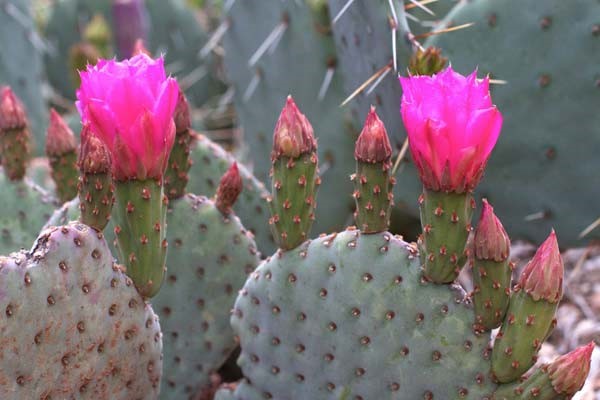Everyting about Opuntia Basilaris ‘Beavertail Cactus’

Opuntia Basilaris, Beavertail Cactus, Beavertail Pricklypear, or Nopal Del Castor, is a low-spreading cactus found in the USA (mostly Mojave) and northwest Mexico. This bushy shrub has flat pads that look like beaver tails, and are covered with tiny spines.
In addition to Mojave and northwest Mexico, you can also find Beavertail Cactus in Arizona, southern Utah, southern Nevada, southern California, and Colorado Deserts; where it grows in arid plains and valleys, and in sandy or rocky soils.
Below we will cover Opuntia Basilaris characteristics, varieties, and all the requirements that this unique cactus has.
Opuntia Basilaris Description
Beavertail Pricklypear is considered a small to medium cactus; growing up to 30 to 60 cm in height and up to 90 to 120 cm in diameter in its natural habitat. When growing indoors, Opuntia Basilaris will not be taller than 40 cm and wider than 10 to 20 cm (depending on the variety).
This cactus has an oval to round stem with a green, blue-green, and sometimes gray-green color with a hint of purple (because of the presence of betacyanins pigments). It is interesting to know that the pads’ texture is different according to the temperature; and it can be glabrous, velvety, smooth, or wrinkled.
Opuntia Basilaris has several areoles with white or brown wool, full of brown to red clustered and short (3 mm) bristles that easily penetrate the skin. As the plant matures, new pads stretch from its lower area. And if there are spines, they are found in the upper rim of the pad; as the Beavertail Cactus is usually spineless.
In late spring to early summer, the Beavertail Pricklypear blesses us with its flowers with a deep magenta-red and sometimes yellow color. The flowers are 5 cm wide and 6 cm long that later turn to globular to obviate 4 cm long fruits with no spines. When ripe, the fruits are tan grey and dry.

Beavertail Cactus Varieties
Different varieties of this succulent have their own coloration, growth habit, flower color, etc. Here are some of its famous varieties:
- Opuntia Basilaris var. Basilaris: growing in throughout f the range of this species, it has oval-shaped pads that grow up to 15 cm (and longer).
- Opuntia Basilaris var. Brachyclada: with an overall smaller shape, it occurs only in chaparral vegetation and deserts.
- Opuntia Basilaris var. Treleasei: this variety is found in Pacific grassland and Mojave Desert of California, with narrow oval-shaped pads and a few spines.
- Opuntia Basilaris var. Longiareolata: narrow wedge-shaped pads are the signature characteristic of this plant, which grows in the Mojave Desert of California, Arizona, and the Grand Canyon.
- Opuntia Basilaris var. Albiflora: this is the white flowering form of the Beavertail Cactus.
Beavertail Pricklypear Care
Opuntia Basilaris care shows us how easy it is to grow this succulent; which makes it a great choice for succulent gardens and collections, rock gardens, Mediterranean gardens, etc. It also not toxic, but can cause allergy for some people.
Here are the most important care tips for the Beavertail Pricklypear cactus:
- Light: thrives best in full sun; tolerates part shade as well.
- Temperature: Opuntia Basilaris cold hardiness is not very considerable, as it tolerates cold up to 0° F.
- Soil: Beavertail Cactus can do well in a wide variety of soils with a basic pH (6 to 8), as long as it is well-draining.
- Water: this is a drought-tolerant plant, and needs little water once established. The best way of watering is the soak and dry method.
- Diseases and Pests: Opuntia Basilaris is usually disease-free. Do not overwater to avoid root rot.
- Propagation: You can propagate this cactus by its stem cuttings, or from its large (0.5 to 1 cm in diameter), round, smooth, and cream-colored seeds with no needed treatment. Propagate during spring and fall for the best results.
This plant also needs zero pruning. Although, you can remove the dead pads to give it a more beautiful appearance. While pruning or transplanting, do not forget to wear suitable gloves.
- In this post:
- Opuntia Basilaris Description
- Beavertail Cactus Varieties
- Beavertail Pricklypear Care



